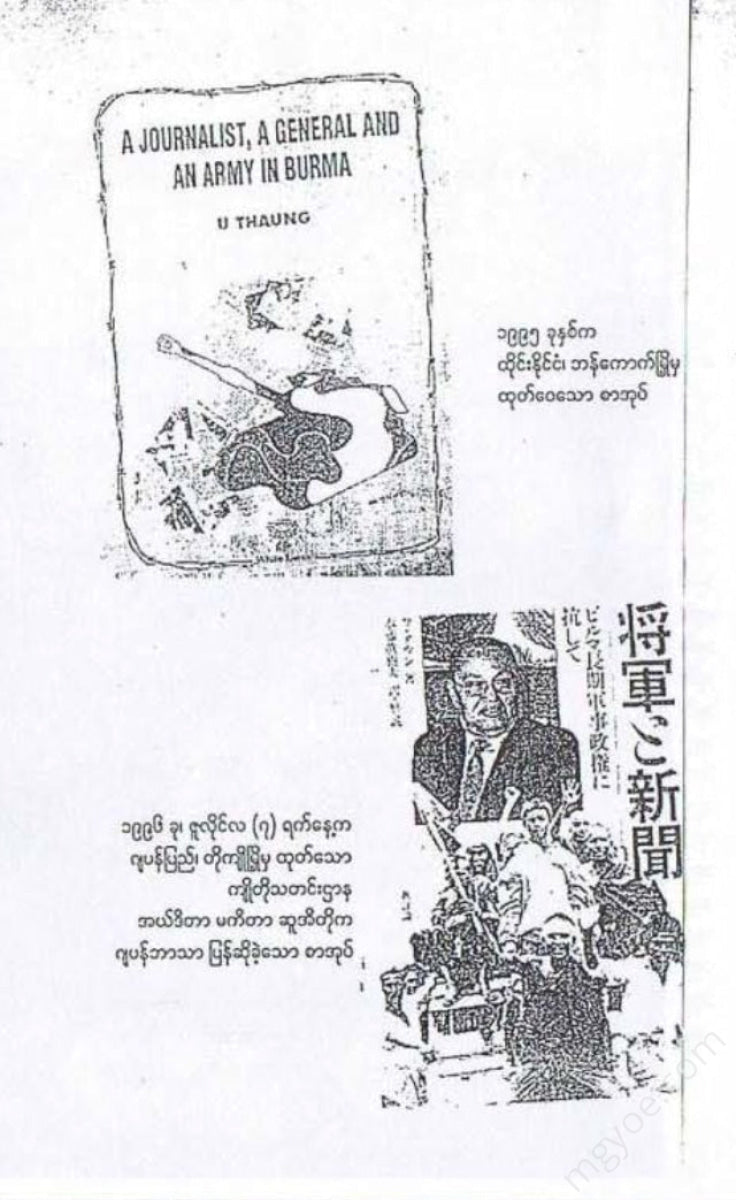Other Websites
Kyamon U Thaung - The Village of the Giants
Kyamon U Thaung - The Village of the Giants
Couldn't load pickup availability
Introduction
Military tactics and news production
“See Colonel Sein Lwin, Minister of Home Affairs and Religious Affairs. He will be waiting for you at (9) o’clock,” Tin Maung’s superior, the Minister of Information, called. Colonel Sein Lwin was the person Tin Maung most wanted to see. Why would he want to see him?
As the deputy director of the Ministry of Information, Tin Maung was responsible for all news matters, so he was often called upon by ministers and party leaders to order news outlets to be shut down and to issue news announcements. However, Colonel Sein Lwin never called him.
According to his position and duties, he interacted with the leaders of the Myanmar Socialist Program Party and government members. They met and became close at meetings and receptions. Colonel Sein Lwin was not among those close to him. I myself avoided meeting him face to face. Because I had met him once. Once I met him, I cherished him for the rest of my life and never wanted to see him again.
It was a dark day, with heavy rain. I can’t forget August 14, 1950, to be exact. At that time, Tin Maung was just a 24-year-old journalist. He was covering the civil war that had been raging for two years. That morning, the Ministry of Information invited reporters and announced a special news item. It was announced that the leader of the Karen National Union, General Saw Ba U Gyi of the Karen National Defense Force, had been killed in a battle. Saw Ba U Gyi, known as the “Billap Pagoda,” was a prominent Burmese political figure.
He was a leader. He was in politics during the Japanese era and worked to reconcile the Karen and Burmese people. When the British returned, he became a minister in the government and advisor to the governor. When Burma was about to gain independence, he went to England to demand the independence of the Karen state. When the British did not give in, he negotiated with U Aung Sa and U Nu and tried to obtain a state for the Karen people.
He led the Karen National League to discuss the rights of the Karen people and when the issue was not resolved, he took up arms. He is said to have died near Mawlamyine, which is now 70 miles from Yangon. He invited 10 journalists to Mawlamyine to cover the news of the fallen rebel leader, and Tin Maung was allowed to take a photo with him. On the plane, the military officers continued to explain the news. It is said that a former British major was also killed along with the Karen leader.
When reporters investigated, they found the rebels and their companions alive. They were told that they had surrendered and were shot dead. “They were planning to send them to the nearest military base, but they ran away. They could not save their lives,” he said. Reporters are not allowed to write the truth. They should write “dead” as the government has announced.
When the reporter arrived at the airport, they were taken to Mawlamyine Hospital. The body had just arrived. The fallen leader was laid out on the morgue. His clothes were so soaked with blood and mud that it was impossible to recognize his original color. He was dragged across the water from the flooded fields by ropes. Only when he reached the village of Shagyi could he be carried by cart. The body had been dead for two days and was already rotting. It was a sad sight.
Saw Ba U Gyi, a minister in the Governor’s Consultative Cabinet, had become very close to reporters during his time as a leader in the Karen-Burmese unity talks. Tin Maung had taken many photographs of him, tall, with a thick beard and neatly dressed in a rich European suit. He was a handsome man, so he was a regular at taking photographs with Prime Minister U Nu. But now, Tin Maung could not even take a good picture of Saw Ba U Gyi’s decrepit body.
After showing the fallen man, they arranged for the winner to take a picture. Captain Sein Lwin, who had just been promoted, was seen with a glass of wine in his hand. (Everyone was treated to a drink for the victory celebration.)
He was still a young man, but he was beginning to grow old. He seemed a little older than Tin Maung. (Two years older) His body was taller and stronger, and his hair was dark. The victor's clothes were no different from those of the vanquished. They were dirty. They were covered in blood and mud. Only two bright gold stars shone on his shoulders. His face was dirty. His strong jaw and thick eyebrows were fierce. His eyes showed cruelty and lack of mercy. .
When Tin Maung took a picture using a Speed Graphie camera, he was able to look at his face up close through the powerful camera lens. He looked for a long time. When he saw such detail, Tin Maung's heart knew. He saw with a clear mind that he was no ordinary man, but a hideous and terrifying creature. Days, months, and years passed.
It was said that the fearsome Captain Sein Lwin had stars on his shoulders, one by one. Tin Maung had risen to the rank of publisher and editor-in-chief of the largest newspaper in Burma. Then, one day, he would meet the inhuman eyes again. It was amazing. It was amazing that they only met for a blink of an eye.
It was July 7, 1962. It was the rainy season, but the sun was shining brightly, without any unusual rain.
To cover the news of student protests at Yangon University

